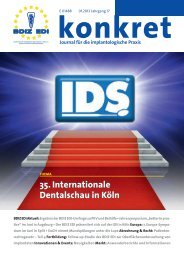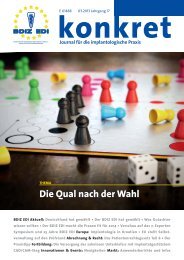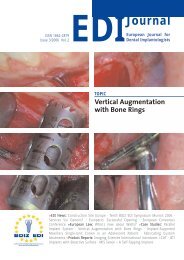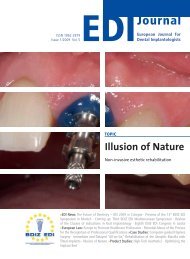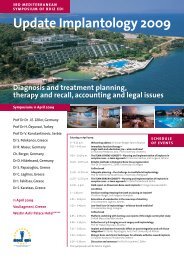EDI - European Association of Dental Implantologists
EDI - European Association of Dental Implantologists
EDI - European Association of Dental Implantologists
You also want an ePaper? Increase the reach of your titles
YUMPU automatically turns print PDFs into web optimized ePapers that Google loves.
66 <strong>EDI</strong><br />
Case Studies<br />
The bone crest was curetted to remove all s<strong>of</strong>t tissue.<br />
While the CT scans provide an excellent image <strong>of</strong><br />
the defect, direct visualization is the only way to accurately<br />
assess its horizontal and vertical dimensions<br />
the amount <strong>of</strong> bone to be harvested from the donor<br />
site. A limited incision in the parietal region revealed<br />
the donor site. No hair needed to be shaved <strong>of</strong>f.<br />
The periosteum was incised and reflected and<br />
bone grafts were outlined using a cutting bur with a<br />
tip diameter <strong>of</strong> 1.5 mm parallel and about 5 cm away<br />
from distant from the midline. Three rectangular<br />
bone grafts 4 x 1 mm in size were designed at the<br />
donor site. The head <strong>of</strong> the round bur was shifted<br />
down to the diploe layer. The oozing <strong>of</strong> blood from<br />
the excision site revealed penetration to the appropriate<br />
anatomical level <strong>of</strong> the skull. The final step was<br />
to use a curved osteotome to free the intended bone<br />
grafts from the donor site, to avoid sourcing any<br />
material from the inner table <strong>of</strong> the skull. Bleeding<br />
from the diploe layer was controlled with bone wax<br />
and the scalp wound was closed using double layer<br />
vertical-mattress resorbable sutures.<br />
The harvested bone was placed in a sterile physiologic<br />
solution or in moist gauze to maintain as much<br />
the vitality <strong>of</strong> the block as possible. The recipient bed<br />
was prepared by perforating with a small, straight<br />
fissure bur. This created bleeding channels in the<br />
recipient bed, assisting the formation <strong>of</strong> neovasculature<br />
from the palatal periosteum. Once the recipient<br />
bed had been prepared, rotary instruments were<br />
used to shape the blocks <strong>of</strong> donor bone to fit the<br />
recipient bed as closely as possible. One block was<br />
adapted and attached on the buccal aspect <strong>of</strong> the<br />
alveolar ridge as a veneer graft, while a second block<br />
was adapted to serve as an onlay graft and attached<br />
to the first calvarial block. To secure the block grafts<br />
in place, two titanium alloy screws per block, at least<br />
1.5 mm in diameter, were used (Fig. 4).<br />
The bone blocks were secured using the lag-screw<br />
technique. With this technique, the hole that is<br />
drilled through the graft is wider than the screw<br />
thread. The bur used to drill the host bone should be<br />
smaller than the diameter <strong>of</strong> the screw. When the<br />
head <strong>of</strong> the screw is tightened against the block, the<br />
graft is compressed onto the host bone surface. The<br />
graft must remain immobile during healing.<br />
Sharp edges <strong>of</strong> the bone blocks were rounded <strong>of</strong>f<br />
with large diamond burs. Gaps around the block<br />
grafts were filled with bone chips harvested from the<br />
donor site. Several authors have reported that resorption<br />
can be reduced by covering the bone graft with<br />
a barrier membrane. However, we believe that barrier<br />
membranes are not necessary with calvarial block<br />
bone grafts, which already show minimal resorption.<br />
Once the graft is secured, closure <strong>of</strong> the s<strong>of</strong>t-tissue<br />
Fig. 4 Panoramic x-ray taken one month after the bone reconstruction: the retention<br />
screws are in place.<br />
Fig. 5 Histologic preparation <strong>of</strong> the external cortical layer<br />
<strong>of</strong> the calvarial graft at implant placement. The picture<br />
shows the typical compact osteonic structures <strong>of</strong> the calvarium,<br />
with signs <strong>of</strong> active remodelling and new vascular<br />
ingrowth. The vital bone containing osteocytes in the<br />
inner core <strong>of</strong> the osteons surrounded lamellar non-vital<br />
bone, suggesting that non-vital bone was recolonized by<br />
blood vessels and osteogenic cells via the Haversian canals (original magnification<br />
x 200; specimens stained with haematoxylin and eosin).<br />
flap requires primary closure without tension. An<br />
incision through the periosteum at the base <strong>of</strong> the<br />
flap usually allows for tissue coverage. Vertical mattress<br />
sutures (Vicryl 3-0) are used to resist any pull on<br />
the wound edges.<br />
The main complication associated with onlay bone<br />
grafts is wound dehiscence with graft exposure. Postoperative<br />
antibiotic and analgesic therapy was routinely<br />
practiced for seven days. Patients were also<br />
given chlorhexidine digluconate (0.2 %) for ten days,<br />
and the sutures were removed after ten to twelve<br />
days. No major complications or evident seromas<br />
were detected at the donor site. After four months <strong>of</strong><br />
healing, the fixation screws were removed under<br />
local anaesthesia, grafts were re-contoured, and the<br />
flap was repositioned to restore an adequate amount<br />
<strong>of</strong> attached gingiva for a better aesthetic result. During<br />
this procedure, a bone biopsy was removed with<br />
a trephine bur and processed for histological testing<br />
to study the vitality, revascularization and remodelling<br />
processes <strong>of</strong> the grafts (Fig. 5). The gingiva was<br />
conditioned by modification <strong>of</strong> the artificial teeth <strong>of</strong><br />
the provisional restoration using composite resin.<br />
After three months <strong>of</strong> s<strong>of</strong>t-tissue healing, an acrylic<br />
radiographic stent was prepared on the base <strong>of</strong> a<br />
diagnostic wax-up <strong>of</strong> the missing teeth according to<br />
the Nobel Guide computer-based planning protocol.<br />
To facilitate the double CT scanning technique and




